BartiniWA-14
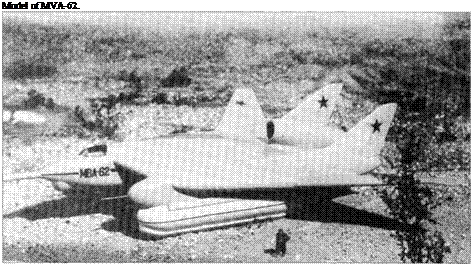
Purpose: To explore the characteristics of a vehicle able to fly as an aeroplane or skim the ocean surface as an Ekranoplan (literally ‘screen plan’, a device covering an area with a screen).
Design Bureau: TANTK named for G M Beriev Taganrog.
Ever one to consider radical solutions, Bartini spent part of 1959 scheming a giant marine vehicle called M. Seaborne at rest, this was to be able to rise from the water and fly at high speed over long distances. It was to make true flights at high altitude, but also have the capability of ‘flying’ just above the sea surface. Such a vehicle was initially seen as urgently needed to destroy US Navy Polaris – missile submarines, but it could have many other applications. The idea was refined into one called 2500, from its weight in tonnes, and ultimately designated M-62 or MVA-62.
TANTK Beriev investigated stability, control and performance of the proposed configuration with the small Be-1. This looked vaguely like a jet fighter, with a front cockpit, large centroplan (central wing) with a turbojet on top, twin floats, outer wings and twin fins and rudders. Under each float was a surfacepiercing V-type hydrofoil, which was not to be a feature of the full-scale vehicle.
Pending funding for this monster, TANTK Beriev were ordered to build three WA-14 prototypes, this being a practical basis for a multirole vehicle. Missions were to include sea/air search and rescue, defence against all kinds of hostile submarines and surface warships, and patrol around the Soviet coastlines. Production craft were to be kept at readiness on coastal airfields. The vehicle was classed as an amphibious aircraft. It was to be developed in three phases. The WA-14M1 was to be an aerodynamics and technology test-bed, initially with rigid pontoons on the ends of the centroplan, and later with these replaced by PVPU inflatable pontoons (which took years to develop). The WA-14M2 was to be more advanced, with two extra main engines to blast under the centroplan to give lift and later with a battery of lift engines to give VTOL capability, and with fly-by-wire flight controls. The third stage would see the VTOL vehicle fully equipped with armament and with the Burevestnik computerised ASW (anti-submarine warfare) system, Bor-1 MAD (magnetic – anomaly detection) and other operational equipment.
Following very extensive research, and tests with simulators, the first vehicle, Nol9172, was completed as an aeroplane. It was tested at the Taganrog WS flying school, which had a concrete runway. Accompanied
by numerous engineers, including deputy chief designer Nikolai A Pogorelov, the test crew of Yu M Kupriyanov and navigator/sys – tems engineer L F Kuznetsov opened the flight test programme with a conventional take-off on 4th September 1972. The only problem was serious vibration of hydraulic pipes, which resulted in total loss offluidfrom one of the two systems.
In 1974 the PVPU inflatable pontoons were at last installed, though their expansion and retraction caused many problems. Flotation and water taxi tests followed, culminating in the start of flighttesting of the amphibious aircraft on 11 th June 1975. Everyone was amazed that Bartini was proved correct in his belief that the rubber/fabric pontoons would retain their shape at high airspeeds. On water they were limited to 36km/h, so later they were replaced by rigid pontoons, with skegs (axial strakes). The forward fuselage was lengthened and the starting (cushion-blowing) engines added. On the debit side, Bartini was also right in predicting that the Lotarev bureau would never deliver the intended battery of 12 RD-36-35PR lift engines, and this made the second and third prototypes redundant.
Bartini died in 1974, and the now truncated programme continued with trickle funding. The blowing engines caused resonance which resulted in breakage of landing-gear doors and buffeting of the rear control flaps. The vehicle never flew again, but did carry out manoeuvre tests on water with reversers added to the blowing engines. TANTK was given higher-priority work with the A-40, A-50 and IL-78.
The entire structure was marinised light alloy, much of the external skin being of honeycomb sandwich. The airframe was based on the fuselage, centroplan of short span but
very long chord, and cigar-like floats carrying the tails. Above the rear on the centreline were the two main engines. The starting engines were mounted on the sides of the nose, and the (unused) lift-engine bay was disposed around the centre of gravity amidships. On each side of this area projected the outer wings, with straight equal taper and thick – ness/chord ratio of 12 per cent, with full-span leading-edge slats, ailerons and flaps hinged 1m (3ft 31/2in) below the wing.
The propulsion and starting (cushion-blowing) engines were all Solov’yov D-30M turbofans, each rated at 6,800kg (14,991 Ib). The starting engines were equipped with cascade-type thrust deflectors, and later with clamshell-type reversers. A TA-6AAPU (auxiliary power unit) was carried to provide electric power and pneumatic power. Bleed air served the cabin conditioning system and hot-air deicing of all leading edges. A total of 15,500kg (34,171 Ib) of fuel was housed in two metal tanks and 12 soft cells.
The cockpit contained three K-36L ejection-seats, for the pilot, navigator and weapon-systems operator. Flight controls were linked through the SAU-M autopilot and complex military navigation and weapon-delivery systems. Had the aircraft undertaken VTOL flights the reaction-control system would have come into use, with six pairs of high-power bleed-air nozzles disposed at the wingtips and longitudinal extremities. For operation from land No 19172 was fitted with the nose and a single main landing gear of a Tu-22, both on the centreline, and the complete outrigger-gear pods of a Myasishchev 3M heavy bomber. Maximum ordnance load, carried on IL-38 racks, comprised 4 tonnes (8,8181b), made up of AT-1 or -2 torpedoes, PLAB-250-120 orother bombs, various mines up to UDM-1500 size, RYu-2 depth charges and various sonobuoys (such as 144 RGB-1U).

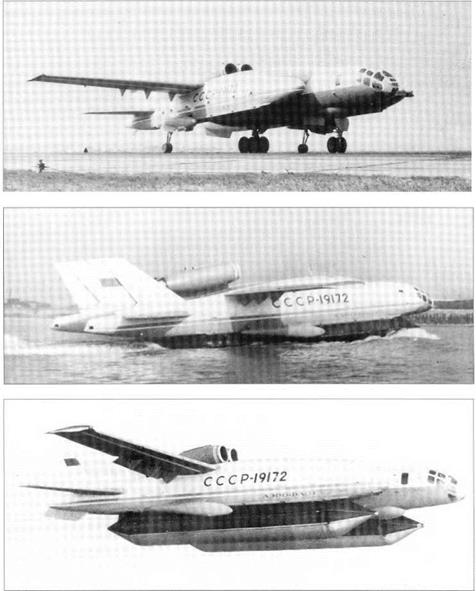
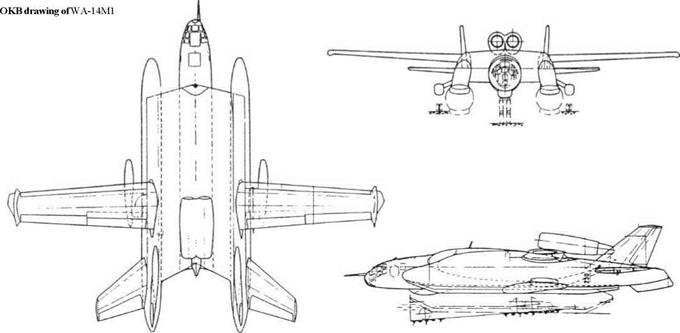 |
One of the incomplete WA-14s was damaged by fire, the third being abandoned at an early stage. The one with which all the flying was done, Nol9172, was retired to the Moni – no museum in a dismantled state, where it carries the number ‘10687’ and ‘Aeroflot’. TANTK had various proj ects for intended production amphibious derivatives. These were grouped under letter T, and two such are illustrated here for the first time.
The WA-14 was an outstandingly bold concept which very nearly came off. There is little doubt it could have led to a practical ver – hicle for many oceanic purposes. In the long term all it achieved was to give T ANTK-B eriev considerable experience in many new disciplines, especially in challenging avionics and flight-control areas. Such a programme would have almost no chance of being funded today.
|
Dimensions |
||
|
Span (wing) |
28.5m |
93 ft 6 in |
|
(over lateral-control pods) |
30.0 m |
98 ft 5 in |
|
Length (as built, excluding PVD |
||
|
instrumentation boom) |
25.97 m |
85 ft 2% in |
|
later |
30.0m |
98 ft 5 in |
|
Wing area |
217.788m2 |
2,344ft2 |
|
Total lifting area |
280 m2 |
3,014 ft2 |
|
Weights |
||
|
Empty (in final form) |
23,236 kg |
5 1 ,226 Ib |
|
(intended weight with lift jets) 35,356 kg |
77,945 Ib |
|
|
Maximum take-offweight |
52,000kg |
1 14,638 Ib |
Performance
Max speed at 6,000m (19,685 ft) 760km/h 472 mph
Patrol speed (also minimum flight speed at low level) 360 km/h 224 mph
Service ceiling 9,000-1 0,000m 32,800 ft (max)
Practical range 2,450 km 1 ,522 miles
Patrol duration at a radius of 800 km (497 miles) 2 hrs 15 min
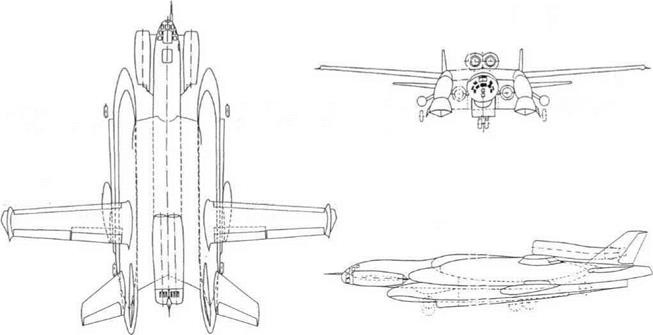
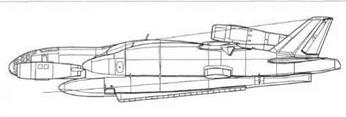 Above: Three-view of WA-14M2 with retractable landing gear. Left: A more detailed side elevation of WA-14M2.
Above: Three-view of WA-14M2 with retractable landing gear. Left: A more detailed side elevation of WA-14M2.
Below: Two of the ‘T’ projects.
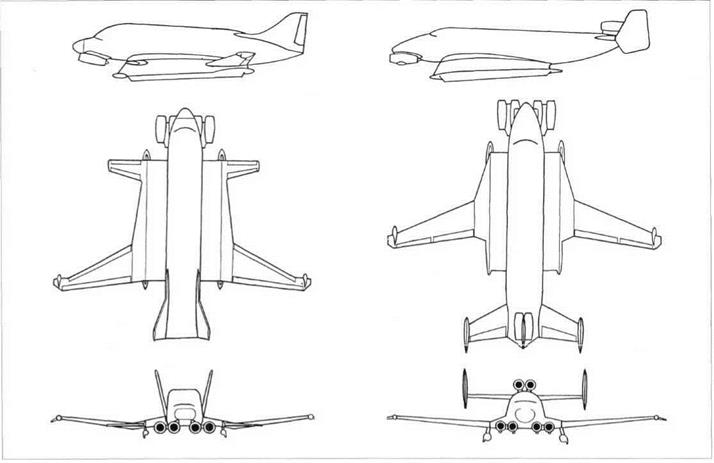
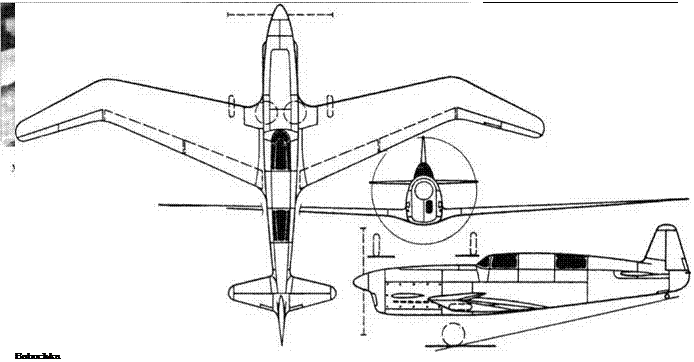 |
Purpose: To test an experimental wing. Design bureau: Kazan Aeronautical Institute, Kazan, Tatar ASSR.
The concept of the wing was that of V N Belyayev, but in order to test it he collaborated with VI Yukharin of the KAI. Partly because it would have been difficult to match centre of lift with centre of gravity by retrofitting the wing to an existing aircraft, it was decided to design an aircraft specially for this purpose. It was called Babochka (butterfly). The project was launched in 1937, and drawings were completed late the following year. Throughout, Belyayev was devoting most of his time to the EOI (see page 27). The single Babochka was being readied for flight when the Soviet Union was invaded. Even though Kazan was far to the East of Moscow, this project was not considered important and those working on it were drafted elsewhere.
This aircraft was essentially a straightforward low-wing monoplane, of fighter-like appearance, with a single (relatively large) piston engine. It is believed that the structure was almost all-metal stressed skin. The key item, the wing, had a high aspect ratio, swept – forward inboard sections and swept-back outer panels. The objective was to make a wing that was flexible yet which in severe positive manoeuvres would deflect upwards without causing a longitudinal pitch problem. Under load, the inner wings deflected upwards, tending to twist with positive angle of incidence, automatically countered by the negative twist of the outer panels. This was hoped to lead to an extension of Belyayev’s concept of a wing that was inherently stable longitudinally.
The inner wings were fitted with inboard and outboard split flaps, while the smaller outer panels carried two-section ailerons.
The engine was mounted on the nose on a steel-tube truss. According to historian V B Shavrov the engine was a ‘Renault 430hp’ (which would have had 12 cylinders and a central air-cooling inlet). In fact it must have been an MV-6, a licence-built Renault with six aircooled cylinders, rated at 210hp. Tandem enclosed cockpits were provided for the pilot and test observer. The tail, remarkably small (reflecting the designer’s belief in the stability of the wing) positioned the horizontal tail wholly in front of the rudder. The landing gears were fully retractable, the main wheels folding inwards into the extended-chord wing roots.
Though there is no reason to doubt that the Babochka would have flown successfully, there is equally no reason to believe that it would have shown any significant advantage over an aircraft with a conventional straight – tapered wing.
 |
Purpose: The initials stood for ‘long-range bomber, flying wing’.
Design Bureau: Designer’s own brigade at the Central Aerodynamics and Hydrodynamics Institute.
Viktor Nikolayevich Belyayev, born in 1896, began his career as a stressman in the OMOS bureau in 1925. He subsequently worked in AGOS, KOSOS-CAH1 (TsAGl), the Tupolev OKB, AviAvnito and Aeroflot. He liked tailless aircraft, and had a fixation on a ‘bat wing’, with slight forward sweep and curved-back tips, which he considered not only gave such aircraft good longitudinal stability but also minimised induced drag. He tested such a wing in his BP-2 glider of 1933, which was towed by an R-5 from Koktebel (Crimea) to Moscow. In 1934 he entered an AviAvnito competition for a transport with a design having twin fuselages, each with a 750hp Wright Cyclone engine and ten passenger seats, but this was not built.
From this he derived the DB-LK bomber. Designed in 1938, the single prototype was completed in November 1939, but (according to unofficial reports) pilots declined to do more than make fast taxi runs, the aircraft being dubbed Kuritsa (chicken) in consequence. In early 1940 this unacceptable situ
ation was ended by the appointment by GK Nil WS (direction of the air force scientific test institute) of M A Nyukhtikov as test pilot, assisted by lead engineer TTSamarin and test observer N I Shaurov. Test flying began in early 1940, at which time Mark Gallai also joined the test team. Nyukhtikov complained that the flight-control system was inadequate and that the landing-gear shock absorbers were weak. In the investigation that followed, the Commission agreed with the first point, but the Head of Nil WS, AI Filin, thought the landing gear satisfactory. He then changed his mind when a leg collapsed with himself at the controls (see photo). Later the main legs were not only redesigned but were also inclined forward, to improve directional stability on the ground and avoid dangerous swing.
Later in 1940 the Nil WS ordered the DB-LK to be abandoned, despite its outstanding performance, and the planned imminent installation of l,100hp M-88 engines. Belyayev had by this time designed a refined version with 1,700hp M-71 engines, but was told that the DB-3F (later redesignated IL-4) would remain the standard long-range bomber.
Belyayev left comprehensive aerodynamic details, showing that the strange wing was of CAHI (TsAGI) MV-6bis profile over the long – chord centroplan (centre section) but Gottin
gen 387 profile over the supposed ‘bat-like’ outer panels. Overall aspect ratio was no less than 8.2, and the outer wings had a leading – edge sweep of minus 5° 42′, with a taper ratio of 7. The airframe was almost entirely a modern light-alloy stressed-skin structure, the wing having five spars. There is evidence the structural design was modern, with most components pressed or even machined from sheet. The outer wings had flaps of the unusual Zapp type, extended to 45°, with Frise ailerons outboard, which even had miniature sections on the back-raked tips. Ahead of the ailerons were slats.
At each end of the centroplan was a fuselage, ofbasically circular section. On the front ofeach was a Tumanskii (Mikulin KB) M-87B 14-cylinder radial engine (Gnome-Rhone ancestry) rated at 950hp, driving a VISh-23D three-blade variable-pitch propeller of 3.3m (10ft l0in) diameter weighing 152kg (335 Ib). The engines were housed in modern long – chord cowlings, with pilot-operated cooling gills. Tanks in the wings and fuselages housed 3,444 litres (757.6 Imperial gallons, 910 US gallons) of fuel, with all tanks protected by nitrogen inerting.
On the centreline at the rear was a large (7.0m2, 75.3ft2) single fin and a 1.94m2 (20.9ft2) rudder with a large trim tab. High on the fin,
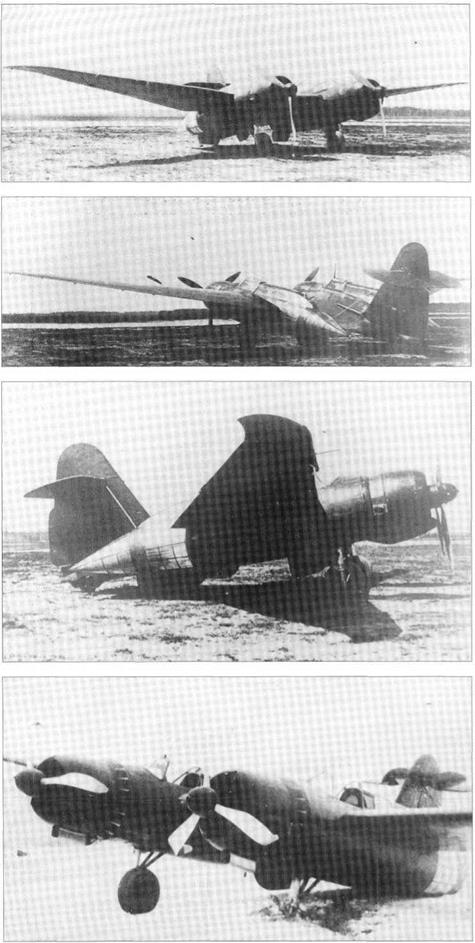
above the rudder, was fixed a small (0.85m2, 9.15ft2) tailplane to which were pivoted the enormous elevators of 4.8m2 (51.7ft2) total area, each with a large tab.
Each fuselage was provided with a main landing gear, with a single oleo strut on the outer side of the axle for a single wheel with a 900 x 300mm tyre, with a hydraulic brake. Each unit retracted rearwards hydraulically. On the centreline at the rear was the fixed castoring tailwheel, with a 450 x 150 tyre.
The intention was that the series (production) DB-LK should have a pilot in the front of the left fuselage, a navigator in front on the right, and gunners in each tailcone. The gunners, entering like the others via roof hatches, should manage the radio as well as pairs of ShKAS 7.62mm machine guns, with a ±10° field of fire in all directions. Two more ShKAS fired ahead on the centreline, aimed by the pilot, and for the six guns a total of 4,500 rounds were provided. Behind each main- gear bay was a bomb bay, with powered doors (see underside view). Each could carry an FAB-1000 (2,205 Ib) bomb, or four FAB-250 (551 Ib) bombs, or many other smaller stores. Predictably, the full military equipment was never fitted, though radio was installed throughout the flight trials.
Despite its strikingly unconventional appearance, the DB-LK appeared to be a practical bomber with outstanding flight performance. Compared with the established WS bomber it had the same number of similar engines, and even half the number of landing-gear oleos, despite having twice the number of fuselages and weapon bays. From today’s distance, it might have been worth pursuing this formula a little further.
|
Dimensions Span 21.6m 70 ft 1014 in Length 9.78 m 32 ft 1 in Wing area 56.87m2 612ft2 Note: various other figures for span (21.4 m) and wing area (59 m2) have appeared. |
||
|
Weights |
||
|
Empty (also given as 5,655 kg) 6,004 kg |
13,236 Ib |
|
|
Normal loaded weight |
9,061 kg |
19,976 Ib |
|
Max loaded weight |
10,672kg |
23,528 Ib |
|
(also given as 9,285 kg) |
||
|
Performance |
||
|
Max speed at sea level, |
395 km/h |
245 mph |
|
at 5,100m (16,730 ft) |
488 km/h |
303 mph |
|
Take-off speed |
1 45 km/h |
90 mph |
|
Max rate of climb |
6.15m/s |
l,210ft/min |
|
Time to climb to 3,000 m |
8.2 min |
(9,843ft) |
|
Time to climb to 5,000 m |
1 3.6 min |
(16,404ft) |
|
Service ceiling |
8,500 m |
27,890ft |
|
Range (with 1,000 kg bombload) |
||
|
at normal gross weight |
1 ,270 km |
789 miles |
|
maximum |
2,900 km |
1,800 miles |
|
Landing speed |
1 50 km/h |
93 mph |
|
Four views of DB-LK, one showing landing-gear failure. |
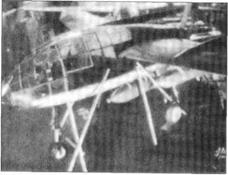
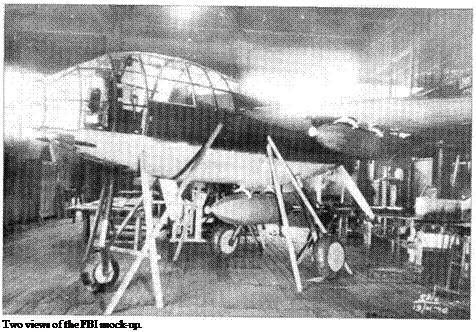
Purpose: Experimental dive-bomber fighter. Design Bureau: V N Belyayev.
No descriptive material has come to light regarding the proposed FBI (Russian for dive – bomber fighter). Only recently have photographs of the mock-up been discovered, marked SEKRETNO and dated 19/1I-40. When these photographs were unearthed and identified nothing was known of such an aircraft, and it was concluded that this was the mock-up of the EOI fighter, especially as Shavrov said this was a twin-boom aircraft. Studying the photographs makes it obvious that the FBI was what its designation states, and not primarily a fighter. Almost the only fact deducible under the heading ‘History’ is that the date is one month after the evacuation of the factories in the Moscow area.
In some respects the FBI design is similar to the EOI fighter. The forward fuselage has two cannon in the same undernose position, the single-seat cockpit has similar features, the wing is in the same mid-position, immediately behind it is the engine driving a three- blade pusher propeller and the twin booms and tail are similar. The differences are that the cockpit area is almost completely glazed, and the landing gears are taller to facilitate loading bombs on five racks (apparently an FAB-500 on the centreline and for an FAB-100 and FAB-50 under each wing).
It is unlikely that Belyayev – even assisted by his team of P N Obrubov, L L Selyakov, E I Korzhenevskii, D A Zatvan, B S Beki and
N Ye Leont’yev – could simultaneously have worked on the DB-LK, Babochka and two advanced pusher fighters and bombers. The inference has to be that the FBI did not progress far beyond the mock-up. This may have been photographed after the workers had left, immediately before it was destroyed, or alternatively it may have been safely located (but abandoned) somewhere East of Moscow.
Specification. No figures known.










